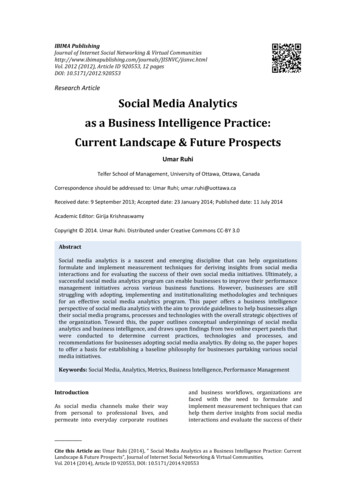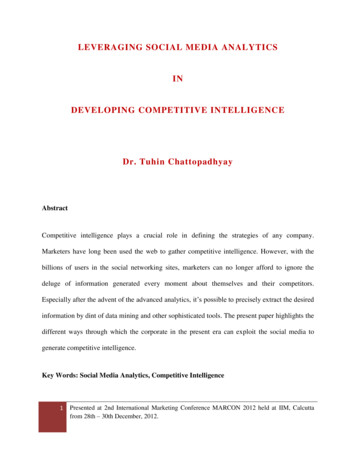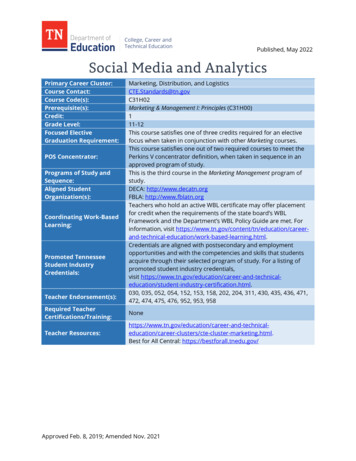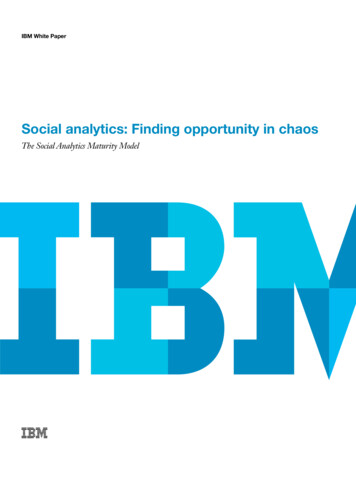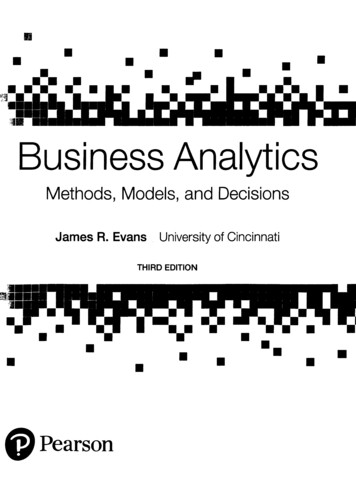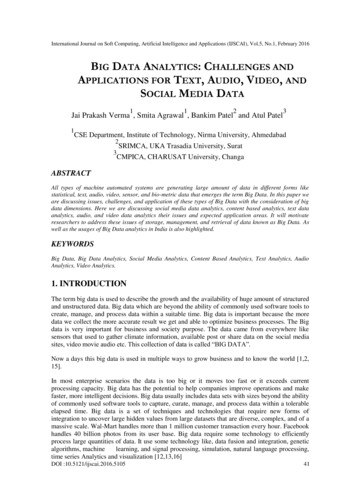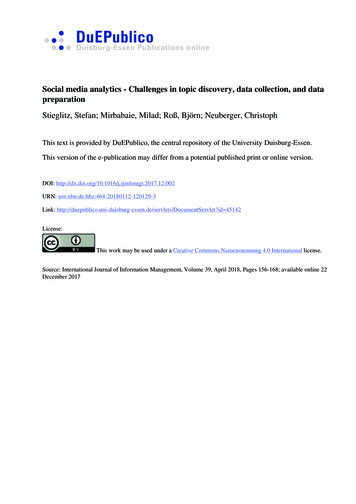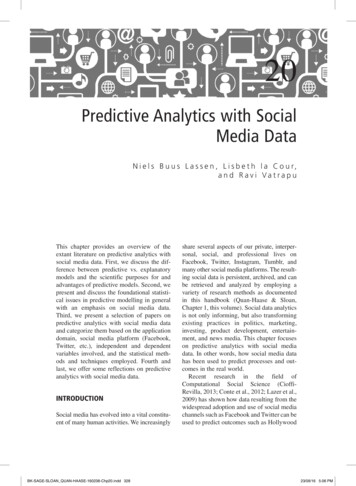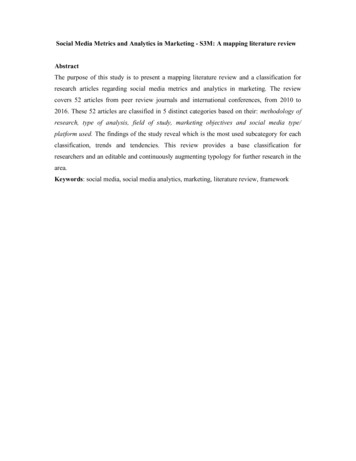
Transcription
Social Media Metrics and Analytics in Marketing - S3M: A mapping literature reviewAbstractThe purpose of this study is to present a mapping literature review and a classification forresearch articles regarding social media metrics and analytics in marketing. The reviewcovers 52 articles from peer review journals and international conferences, from 2010 to2016. These 52 articles are classified in 5 distinct categories based on their: methodology ofresearch, type of analysis, field of study, marketing objectives and social media type/platform used. The findings of the study reveal which is the most used subcategory for eachclassification, trends and tendencies. This review provides a base classification forresearchers and an editable and continuously augmenting typology for further research in thearea.Keywords: social media, social media analytics, marketing, literature review, framework
1. IntroductionWeb 2.0 tools and the appearance of social media seem to have redefined the marketingstrategy, research and practice, broadening marketing’s potential. These potentials go beyondcustomers’ information and expand on commitment and engagement levels. Constantinidesand Fountain (2008) define Web 2.0 “as a collection of open-source, interactive and usercontrolled online applications expanding the experiences, knowledge and marketing power ofthe users as participants in business and social process [ ] supporting the creation ofinformed users’ networks facilitating the flow of ideas and knowledge by allowing theefficient generation, dissemination, sharing and editing/ refining of information content”.Social media produce a vast amount of measurable useful data to analysts and marketerswhose goal is to monitor and analyze behavioral targeting, brand loyalty and furthermarketing performance indicators, rendering these data effective. To do that, specificmarketing metrics goals need to be clearly defined. Without a specific plan, regarding alsothe key performance indicators choices, data analysts together with marketers will fail todirect the social media data into useful insights for the companies. For that purpose, firmsmust precisely raise questions and search answers from social media listening in order totransform data in social media metrics. Social media analysis, therefore, consists ofcollecting, measuring, evaluating and finally interpreting data (Kaplan & Haenlein, 2010).Since the first appearance of social media, marketers have noticed the potential of suchtechnology in business (Mangold & Faulds, 2009). Social media can serve as an effectivemarketing tool in business, valuable for both consumers and companies, offering a widerange of opportunities (Kaplan & Haenlein, 2010). Therefore, social media show anunprecedented increase of use inside business. Even though, understanding social media is acrucial, but not a simple procedure. Several definitions are classified in order to fully explorethe dynamics of social media in marketing.2
This study presents a complete base for understanding and describing social media metricsand social media analytics related to marketing strategy, policy and research, by reviewingthe relevant literature. The objective of this paper is an extensive review of articles related tosocial media metrics and analytics in marketing, creating a mapping review/ systematic mapof the relevant material. The primary goal in this article is to create a conceptual classificationscheme (named S3M) for the extant literature by using five distinct dimensions/ criteria ofclassification, such as: Methodology of research, Type of analysis, Field of study, Marketingobjectives, and Social media types/ platforms. As a result, the most used subsectors fromeach category are identified, featuring the new upcoming trends in social media marketing.The findings of this study are expected to benefit researchers and marketers by helping themto better understand what has been hitherto achieved. It is our primary hope that the proposedframework will serve as a valuable classification system for researchers, academics andpractitioners who conduct similar research.The paper is structured as follows. The next section presents the research methodology wefollow. In the following section we present the classification of the literature, providing adiscussion section for each category. The final section summarizes our work, offeringconcluding remarks, future research directions and limitations that rise from our study.2. Research methodologySocial media marketing as a science field is difficult to restrict only in few specificdisciplines. Τhis difficulty arises due to the multidisciplinary nature of the sciences andindustry fields involved. Based on our proposal, articles associated to S3M can be found infive types of journals: Marketing and e-Marketing, E-Business and Management, Behavioralsciences, ICT/ Information systems and Social media. In order to limit the collection ofarticles, we take some restrictions into consideration. The articles were initially searched on3
Internet and academic databases such as Science Direct, Scopus and Emerald. Articles frombooks and book chapters are excluded from the research. The search returned 101 articles,covering the time span 2011-2016. Of them, 35 were rejected due to lack of compatibility ofthe content with our research scope. From the 66 remaining relative articles, we excluded 6,for being white papers. From the remaining 60 articles, 52 are scientific articles from peerreview journals and 8 from conferences and proceedings. Each article was reviewed andclassified initially into the five above mentioned categories and furthermore in relation withthe year of publication. The year distribution can reveal useful outcomes for the researchtendencies.As it is shown in Figure 1, the research has increased significantly since 2012. This yeartogether with 2014 contribute 8 articles. The pick on publications is noticed during 2013 with12 articles. 2014 and 2015 present a significant decrease in publications with 2016 showing asmall promising increase.1510502010 2011 2012 2013 2014 2015 2016Figure 1: Year of distribution / number of articles3. Classification of the literatureThe amount of the techniques related to social media and their applications in order to spreadbrand awareness or promote particular products is called Social Media Marketing (SMM).SMM uses mainly the features of social media, such as online communities, social data etc.(Neti, 2011). In the literature, social media marketing is combined with metrics and/ or4
analytics tools, methodologies and techniques. Social media metrics represent the tangibleoutcome of monitoring, measuring, reporting, calculating content from social media.Although there is no specific classification system for metrics, researchers can pattern themafter: time, reach, relationship, conversion and retention measurements. However,considering that metrics are not yet fully standardized, it depends on the marketer, who setsthe marketing goal, to decide the most suitable metric for a certain measurement. Socialmedia produce a vast amount of data, known also as social data, consisting the next phase foran analyst; the social media analysis (SMA). More specifically, SMA consists of gatheringand analyzing the data in order to take decisions for businesses. Next, we present eight maindefinitions for analytics in Table 1.Table 1: Definitions for Social Media AnalyticsAuthor(s)DefinitionsDaniel, Hsinchun, Lusch, [ ] developing and evaluating informatics tools andand Shu-Hsing (2010)frameworks to collect, monitor, analyze, summarize,and visualize social media data, usually driven byspecific requirements from a target application.Yang, Kiang, Ku, Chiu, and [ ] developing and evaluating informatics tools andLi (2011)frameworks to measure the activities within socialmedia networks from around the web. Data onconversations, engagement, sentiment, influence, andother specific attributes can then be collected,monitored, analyzed, summarized, and visualized.Mayeh,Scheepers,Valos (2012)and [ ] scanning social media to identify and analyzeinformation about a firm’s external environment inorder to assimilate and utilize the acquired externalintelligence for business purposes.5
Author(s)DefinitionsGrubmüller, Götsch, and [ ] social listening and measurements [ ] based onKrieger (2013)use generated public content (such as postings,comments, conversations in online forums, etc.)Sterne and Scott (2010)SMA is the study of social media metrics that help drivebusiness strategy.Nielsen (2012)SMA is the ability to analyze performance of socialmedia initiatives and social data for businessintelligence.Bensen Connie CompanyDell [ ] consist on web analytics, engagement and revenuegenerated from social media.(conniebensen.com)Awareness (2012)[ ] an evolving business discipline that ompetitive, prospect, consumer, and customer) andsocial activity generated by brands across socialchannels. SMA enable organizations to act on thederived intelligence for business results, improvingbrand awareness and reputation, marketing and saleseffectiveness and customer satisfaction and advocacy.Furthermore, we classify each article based on five different criteria. More analytically, wesubdivide the articles based on methodology, the specific type of analysis, the field of study,the marketing objectives and the social media types/ platforms used. As a result, the mostcommon subsectors of each category can be identified, featuring the new upcoming trends onsocial media marketing. The findings are expected to benefit researchers and marketers byhelping them better understand what has been hitherto achieved.6
Creating a classification constitutes a complex concept to manipulate and conceive,especially in new scientific fields, where literature is still in its early stages. As Bailey (1994)defines, classification is one of the most central and generic of all our conceptual exercises,being the foundation and a necessary process in social science. Typology and taxonomy aretwo terms that define classification. Typologies are characterized by labels and names. Weuse the term typology, instead of taxonomy, because our classification system was derived ina deductive manner, without using any cluster analysis or other statistical method, as it occurswith taxonomies. Initially, we did not know which would be our labels, in order to classifythe articles. Our selection of articles contained a plethora of labels, which made our mappingprocess quite complex but challenging. By studying carefully all the articles, we firstidentified several methodologies, types of analysis, fields of study and marketing objectives.Based on this study, we formed the subsequent Table 2 with the basic labels. This firstcollection of labels is editable, so future researchers can add, unify or divide the differenttopics.Table 2: S3M typology framework for social media metrics and analytics on marketingMethodology ofLiterature review and/ or Theoretical approachresearchSurveysQuestionnaire-based researchNon questionnaire-basedresearchType of analysisPredictive analysisNatural language process (NLP) – Text analysisEffectuation analysisStatistical analysisSentiment analysisBehavioral analysisSocial media activity analysisContent analysis7
Field of studyBankingEducationChild welfare and advocacyTourism industryStock marketEntertainmentE-governmentFood industryAlternative marketingClothingMarketingAwareness & BrandingobjectivesEngagementeWOM advertising & promotionPredictive marketing researchConsumer behavior researchSocial capital - Value (business, firm equity) - ROIRelationship marketing: CRM & social CRMSocial media type/Social networking sitesFacebook, Hi5, Linkedin,MyspaceplatformBlogsBlogspot, digg wordpressMicroblogsTwitter, twitxr, tweetpeek, plurkContent communities -Youtube, Flickr, SlideshareVideo sharing sitesForums - discussionPhpbb. Phorum, skype,messenger, google talkHaving this classification as a base scheme we studied the articles again, this time in order toclassify each one in one or more categories. Our scheme lacks of mutual exclusivity, sinceone article may belong to more than one category. Reviewed articles are classified into fivecategories and each of them is discussed as follows.8
3.1 Methodology of researchStudies follow different approaches related to the methodology used. This depends on theproblem’s nature and the research field (Noor, 2008). Diverse studies exclusively review theliterature. Usually these studies are qualitative and theoretical. We detected 10 articles thatperform reviews and/ or theoretical research. On the other hand; other studies performquantitative research using questionnaires. Our study revealed 13 relative articles. Theremaining articles do not use questionnaires and form the third category of Table 3 with 27articles.Table 3: Articles' classification concerning the methodology of researchMethodology of researchArticlesPercentage ofarticles/ total (n/52)Literature review and/ orFan and Gordon (2014); Gayo-Theoretical approachAvello et al. (2013); Ghezzi,Gastaldi, Lettieri, Martini, andCorso (2016); Hanna, Rohm, andCrittenden (2011); Malthouse,Haenlein, Skiera, Wege, andZhang (2013); Neirotti, Raguseo,and Paolucci (2016); Nettleton(2013); Praude and Skulme(2015); Stephen (2016); P.Yadav, Banwari, Parmar, andManiar (2013)919.2%
SurveyQuestionnaire-Carim and Warwick (2013);based researchFischer and Reuber (2011);Godey et al. (2016); Guesalaga(2016); Kim and Ko (2012); Lee,Yen, and Hsiao (2014);Michaelidou, Siamagka, andChristodoulides (2011); Nadeem,Andreini, Salo, and Laukkanen(2015); Paek, Hove, Jung, andCole (2013); Panagiotopoulos,Shan, Barnett, Regan, andMcConnon (2015); Praude andSkulme (2015); Sheth, Sisodia,and Sharma (2000); Tiago andVeríssimo (2014)1025%
NonAndrew, Mudd, Rich, and Bruichquestionnaire-(2012); Asur and Hubermanbased research(2010); Bernabé-Moreno,Tejeda-Lorente, Porcel, Fujita,and Herrera-Viedma (2015);Braojos-Gomez, Benitez-Amado,and Javier Llorens-Montes(2015); Castronovo and Huang(2012); Chen, Tang, Wu, andJheng (2014); Geurin and Burch(2016); He, Zha, and Li (2013);Jang, Sim, Lee, and Kwon (2013);Kavanaugh et al. (2012); Kelling,Kelling, and Lennon (2013);Kontopoulos, Berberidis,Dergiades, and Bassiliades(2013); Lau, Li, and Liao (2014);Lieberman (2014); Mostafa(2013); Pehlivan, Sarican, andBerthon (2011); Podobnik(2013); Qiu, Rui, and Whinston(2014); Ribarsky, Xiaoyu Wang,and Dou (2014); Rohm, Milne,and Kaltcheva (2012); Sabate,Berbegal-Mirabent, Cañabate,and Lebherz (2014); Smith,Fischer, and Yongjian (2012);Xiang, Schwartz, Gerdes Jr, andUysal (2015); Xie et al. (2012);M. S. Yadav, de Valck, HennigThurau, Hoffman, and Spann(2013); Yakushev and Mityagin(2014); Yu, Duan, and Cao (2013)1150%
The generic category of survey-related articles, both questionnaire-based and not, contributesmore that 84% of papers. This can be explained by the fact that social media scientists preferto contribute with primary research articles rather than review-based researches, since thefield is quite new and presents a huge research development margin. Though this numericconclusion can be evidenced by findings, we believe that theoretical approaches are stillnecessary and form a solid base for conducting primary research.3.2 Type of analysisAs S3M is a nascent developing field with challenges and opportunities for further researchexploration, this Table is designed to assist researchers to obtain the basic knowledge but alsoto find gaps and limitations, not yet analyzed. The tendencies towards specific research canbe revealed also from the next Table. As Gartner (2013) defines, social analytics includesentiment analysis, NLP, text analysis, predictive and content analysis. We enlarge thisdefinition by adding also statistical and behavioral analysis, as possible categories, in ourtaxonomy. Only one article performs effectuation analysis which is the process forentrepreneurial decision-making (Fischer & Reuber, 2011). These eight categories form theclassification for Table 4.Table 4: Articles' classification concerning the type of analysisType of analysisArticlesPercentage of(primary dataarticles/ totalcollection and/ or(n/52)metric analysis)Predictive analysisAsur and Huberman (2010); Chen et al. (2014);5.8%Qiu et al. (2014)Natural LanguageAsur and Huberman (2010); He et al. (2013); Jang1215.3%
Type of analysisArticlesPercentage of(primary dataarticles/ totalcollection and/ or(n/52)metric analysis)Process (NLP) –et al. (2013); Kontopoulos et al. (2013); MostafaText analysis(2013); Xiang et al. (2015); Yakushev andMityagin (2014); Yu et al. (2013)Effectuation analysisFischer and Reuber (2011)1.9%Statistical analysisHe et al. (2013); Podobnik (2013)3.8%Sentiment analysisChen et al. (2014); Jang et al. (2013); Kontopoulos13.4%et al. (2013); Lau et al. (2014); Mostafa (2013);Xiang et al. (2015); Yu et al. (2013)Behavioral analysisAndrew et al. (2012); Mostafa (2013); Qiu et al.7.7%(2014); Xie et al. (2012)Social media activityBernabé-Moreno et al. (2015); Guesalaga (2016);analysisHe et al. (2013); Lieberman (2014); Praude and13.4%Skulme (2015); Rohm et al. (2012); Sabate et al.(2014)Content analysisBernabé-Moreno et al. (2015); Geurin and Burch15.4%(2016); He et al. (2013); Jang et al. (2013); Neirottiet al. (2016); Panagiotopoulos et al. (2015);Ribarsky et al. (2014); Smith et al. (2012); Xiang etal. (2015)S3M is not yet fully standardized so it is normal that the different categories mix with eachother. This is the reason why many papers fit more than one category. Nevertheless, even ifclassification is not yet fully clarified, we extract the next outcome by observing Table 4.NLP and text analysis, sentiment analysis, content and social media activity analysis are the13
dominant categories. This observation can be explained by the fact that data contain insightsfor customers and information for marketers so as to predict useful outcomes.3.3 Field of studyOur review ends up with 10 specific market fields of study. Only 18 articles clearly focus onspecific fields of study, while the rest are generic. We list these fields in Table 5.Table 5: Articles' classification concerning the field of studyField of studyArticlesPercentage ofarticles/ total(n/52)BankingRibarsky et al. (2014)1.9%EducationKelling et al. (2013)1.9%Child welfare and Paek et al. (2013)1.9%advocacyTourism industryBernabé-Moreno et al. (2015); Kontopoulos et al.11.5%(2013); Mariani, Di Felice, and Mura (2016); Neirotti etal. (2016); Sabate et al. (2014); Xiang et al. (2015)Stock marketYu et al. (2013)1.9%EntertainmentAsur and Huberman (2010); Geurin and Burch (2016);5.7%(movies, sports)Podobnik (2013)E-governmentKavanaugh et al. (2012)1.9%Food industryHe et al. (2013); Panagiotopoulos et al. (2015)1.9%AlternativeCastronovo and Huang (2012)1.9%marketing14
Field of studyArticlesPercentage ofarticles/ total(n/52)(viral, email,guerilla etc.)Clothing1.9%Nadeem et al. (2015)As we notice, articles related to the tourism industry hold the largest percentage with sixarticles. In a total of 52 articles, this number represents the 11.5%, but among the 18 thatfocus on specific categories, the percentage rises in 33.3%. The fact that one third of thearticles belong in the tourism industry was highly expected since tourism represents one ofthe most profitable industries worldwide, contributing to the global economy more than 48trillion dollars for the same time span of our research, from 2010 to 2016 (Statista.com,2016).3.4 Marketing objectivesBusiness organizations create marketing programs, activities, and campaigns in order tomove their current/ potential customers to the buyer’s journey, designed to align marketinggoals and sales activities. Several marketing objectives including specific actions wereidentified, such as brand awareness, engagement, marketing and especially customerresearch, behavioral targeting, e-WOM & promotion policy, relationship management &social CRM and social capital value including ROI questions /assessment.Brand awareness means the exposure of the target audience to brand content and message,while engagement generates further actions taking into consideration the brand content/offers. Marketing and customer research have been identified by marketers as important andcommon objectives related to the social media use, giving them valuable informationregarding customers impressions, sentiment, satisfaction in order to estimate the15
conversion/purchase potential. Furthermore, the activation of customers’ influence based onreferrals, advocacy activities and evangelism inspiration for products/ services constitutes themarketing objective of a positive eWOM promotion policy. Relationship marketingobjectives based on social CRM is the new concern in the marketing world, and with goodreason (Hoffman & Fodor, 2010; Pentin, 2011). As social media explode among businessesand customers, monitoring, managing and exploiting the resulting data become essential tasksfor almost any marketer. Companies are anxious to meet customers where they are in thesocial media realm looking for the tools to get involved and gain access. Social CRMsoftware works in conjunction with traditional CRM systems to track customer behavior, as atool that is part of a social media strategy.The study of the articles revealed initially 7 marketing objectives supported by social media.Table 6 presents the articles based on each objective they serve.Table 6: Articles' classification concerning the marketing objectives.Marketing objectivesArticlesPercentage ofarticles/ total(n/52)Awareness & BrandingAndrew et al. (2012); Kim and Ko (2012);13.4%Lieberman (2014); Mostafa (2013); Rohmet al. (2012); Sabate et al. (2014); Smith etal. (2012)EngagementFischer and Reuber (2011); Guesalaga(2016); Malthouse et al. (2013); Marianiet al. (2016); Osborne and Ballantyne(2012); Paek et al. (2013);Panagiotopoulos et al. (2015); Rohm et al.(2012); Sabate et al. (2014); Tiago andVeríssimo (2014)1619.2%
Marketing objectivesArticlesPercentage ofarticles/ total(n/52)Chen et al. (2014); Stephen (2016)1.9%Predictive marketingAsur and Huberman (2010); Gayo-Avello9.6%researchet al. (2013); Kim and Ko (2012); Qiu eteWOM advertising &promotional. (2014); Yakushev and Mityagin (2014)Consumer behaviorBernabé-Moreno et al. (2015); Godey etresearchal. (2016); Jang et al. (2013); Mostafa19.2%(2013); Nadeem et al. (2015); Ribarsky etal. (2014); Rohm et al. (2012); Stephen(2016); Xiang et al. (2015); Xie et al.(2012)Social capital - ValueBraojos-Gomez et al. (2015); Fan and(business, firm equity) -Gordon (2014); Godey et al. (2016); He etROIal. (2013); Lee et al. (2014); Neirotti et al.15.4%(2016); Pehlivan et al. (2011); Yu et al.(2013)Relationship marketing:Geurin and Burch (2016); Malthouse et al.CRM & social CRM(2013); Nadeem et al. (2015); Osborne9.6%and Ballantyne (2012); M. S. Yadav et al.(2013)Engagement, consumer behavior research and relationship marketing represent the mostdominant among the other categories with 10, 10 and 8 articles, respectively. All these threecategories have the consumer/customer as a common factor. The consumer-centric marketingwas presented as the upcoming trend a few years ago and the current literature and ourfindings demonstrate that tendency towards that direction (Osborne & Ballantyne, 2012;17
Sheth et al., 2000). Of the 47 articles related to some marketing objective, presented in Table6, the 59.6% regards consumer-centric articles.3.5 Social media types/ platforms and suggested frameworkTable 7 represents the articles’ distribution for the social media types or the platform used. Inorder to create this Table, we base our taxonomy on Kaplan and Haenlein (2010),Constantinides and Fountain (2008) and Mangold and Faulds (2009). Α difference betweenthese three articles is that the first two use the term Content communities for YouTube andthe third one, video sharing sites.Table 7: Articles' classification concerning the social media types/ platformsSocial media types/ArticlesPercentage ofplatformsarticles/ total(n/52)Social Networking Sites (SNS) Andrew et al. (2012); Carim and38.5%Warwick (2013); Chen et al. (2014); Heet al. (2013); Kavanaugh et al. (2012);Kim and Ko (2012); Lee et al. (2014);Lieberman (2014); Mariani et al. (2016);Nadeem et al. (2015); Paek et al. (2013);Podobnik (2013); Ribarsky et al. (2014);Rohm et al. (2012); Sabate et al. (2014);Sheth et al. (2000); Smith et al. (2012);Tiago and Veríssimo (2014); Xie et al.(2012); M. S. Yadav et al. (2013)BlogsPaek et al. (2013); Yakushev and5.8%Mityagin (2014); Yu et al. (2013)MicroblogsAsur and Huberman (2010); BernabéMoreno et al. (2015); Carim andWarwick (2013); Fischer and Reuber(2011); He et al. (2013); Kavanaugh et1832.7%
Social media types/ArticlesPercentage ofplatformsarticles/ total(n/52)al. (2012); Kelling et al. (2013); Kimand Ko (2012); Kontopoulos et al.(2013); Lieberman (2014); Mostafa(2013); Paek et al. (2013); Ribarsky etal. (2014); Rohm et al. (2012); Sheth etal. (2000); Smith et al. (2012); Yu et al.(2013)Content communities – VideoCarim and Warwick (2013); Geurin andsharing sitesBurch (2016); Jang et al. (2013);9.6%Kavanaugh et al. (2012); Smith et al.(2012)ForumsYu et al. (2013)1.9%In a total of 52 articles, 46 of them fit Τable 7 with several articles studying multiple socialmedia types or platforms. Articles related to Facebook and Twitter, dominate with 20 and 17articles, and 38.5% and 32.7% respectively. These results were rather expected, given the factthat 1.86 billion Facebook users and 320 million Twitter users own an active account on thesetwo most visited and diffused SNS and microblog platforms. In global scale, Facebook isused by 54% of global internet users, so it is expected that science will also be of interest forthese two platforms.Summarizing our findings, with respect to the corpus of all articles, we notice a peak onpublications in 2013 followed by a decrease the next two years. An important finding is that2016 represents a small but constant increase in the number of publications, showing anoverall increase of interest in social media marketing analysis. Trends show the tourismindustry, Facebook and Twitter as well as consumer-centric marketing to be the dominant19
categories, platforms and concepts behind social media marketing strategies. On the otherhand though, these trends may bring to the surface gaps in other fields that need attention andresearch.4. Future research directions & limitationsMarketing science, together with information technology, has great interest in understandingand analyzing social media and their created data. We present a complete-scale study, aimingto create a typology for social media metrics and analytics related articles, within acontinuously incremental and editable typology. The findings contribute to the literature inseveral ways. The proposed typology is flexible, which means that future literature reviewson a subject can contribute, based on the typology, by adding items and categories.Regarding specific outcomes, from the Table 3 it becomes clear that primary data collectionis the most used method on S3M and the data used for analysis, originate from primarymetrics. Another useful outcome is the platform used. On today’s social media research,Facebook and Twitter are the dominant platforms and so, the biggest part of the literature isfocusing on these two platforms. The above conclusions can help researchers to understandbetter the tendencies of the diverse field, but also reveal research gaps and lacks in theliterature. We believe that the presented paper presents potential for applications in manydomains, ranging from marketing to academic or business research. By knowing how toeffectively measure the social media value, companies and individuals can produce insightsthat allow improvement in promoting products and services. Our paper, presents also somelimitations. The research was conducted with keywords such as "social media marketing" andnot separately for each marketing objective (e.g. branding, engagement, etc.). This fact,limited the number of articles. Future studies must approach the S3M topic, by searching (andadding as keywords) every field, platform and marketing objective, separately. This type of20
search will lead to diverse studies, focusing on a specific direction. Our proposed S3Mtypology framework should trigger future research enabling the incorporation of furthercriteria.21
ReferencesAndrew, L., Mudd, G., Rich, M., & Bruich, S. (2012). The Power of Like: How BrandsReach and Influence Fans Through Social Media Marketing. Journal of AdvertisingResearch. doi: 10.2501/JAR-52-1-040-052Asur, S., & Huberman, B. A. (2010). Predicting the Future with Social Media. Paperpresented at the Proceedings of the 2010 IEEE/WIC/ACM International Conferenceon Web Intelligence and Intelligent Agent Technology - Volume 01.Awareness, I. (2012). Actionable Social Analytics: From Social Media Metrics to BusinessInsights Retrieved 14/12/2015, from %E2%80%90Analytics.pdfBailey, K. D. E. (1994). Typologies and taxonomies: an introduction to classificationtechniques (Vol. 102): Sage.Bernabé-Moreno, J., Tejeda-Lorente, A., Porcel, C., Fujita, H., & Herrera-Viedma, E. (2015).CARESOME. Know.-Based Syst., 80(C), 163-179. doi: 10.1016/j.knosys.2014.12.033Braojos-Gomez, J., Benitez-Amado, J., & Javier Llorens-Montes, F. (2015). How do smallfirms learn to develop a social media competence? International Journal ofInformation Management, 35(4), 443-458. 003Carim, L., & Warwick, C. (2013). Use of social media for corporate communications b
7klv vwxg\ suhvhqwv d frpsohwh edvh iru xqghuvwdqglqj dqg ghvfulelqj vrfldo phgld phwulfv dqg vrfldo phgld dqdo\wlfv uhodwhg wr pdunhwlqj vwudwhj\ srolf\ dqg uhvhdufk e\ uhylhzlqj

